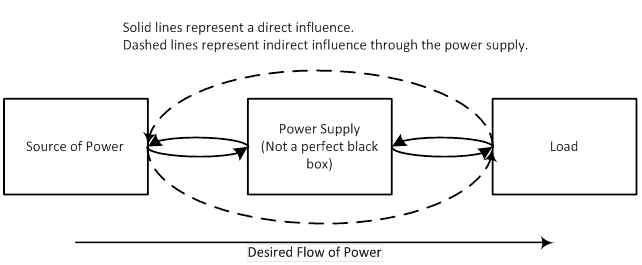Power Supplies Serve to Match Load to Source
There are many commonly available sources of electrical power as well as endless types of sources yet to be discovered or developed. We also have countless applications for this power.
However, most applications can not take power directly from the source. There must be a matching process that changes the source power to useable power for applications. This matching process is the function of the electronic power supply.
Notice that the phrase “electronic power supply” is a misnomer. An electronic power supply does not create power — rather, it simply transforms the available source power to a useful form for your application.
Figure 1 illustrates the relationships between the source and the power supply and the power supply and the load.
Figure 1: Power supply relationsip with the source and the load.
A System Level Approach Needed at the Right Time
Approaching power supply application, specification, and design with a system level perspective is of critical importance for the success of projects. The system includes the source, the load, and even the environment around the power supply. Additionally the system power supply must be treated with the same importance as other aspects of the system design.
The source and load characteristics must be understood before the power supply requirements are determined. The time to evaluate for power supply specifications is right after the initial load and source characteristics are known. It is quite common that a suitable power supply design is not reasonably possible given the initial load and source characteristic determination. If this is the case, either the load or source characteristics need to be changed before proceeding further with the system design. Otherwise, the result will be a failed project or a project with extremely high cost overruns. This problem is a very common mistake that is easily preventable.
A Major Cause of Project Catastrophes
Perhaps a reason for project failures is a belief that electronic power supplies are perfect black boxes, capable of perfectly supplying power to the load. They are not perfect black boxes and failure to consider their limits and adverse behavior can be catastrophic to a project program.
The cost to make make design changes increases exponentially as time in the development cycle progresses. This exponential characteristic happens due to the work that must be done to re-document, re-test, and re-work designs and existing product. This is called the waterfall effect. Problems not found until late in the development cycle can prove to have catastrophic cost consequences. Don’t think that the power supply design can wait till the end! Design power supplies into your system at the right time.
Power Supplies are Multi-Disciplinary and Complex
Electronic power supplies, especially switch-mode type, have very complex analog energy transfer processes and require a diverse skill set to design. The skill set includes not only knowledge of high frequency with high power analog electronics, but also sufficient knowledge of mechanical packaging and heat transfer concepts to prevent the unit from overheating.
Many vendors have simplified switching power supplies for general purpose applications. However, a system knowledge of the source and the load are still important as well as understanding the characteristics and limitation of the power supply itself.
Upcoming Topics
This series of articles about specifying power supplies with a system perspective will cover in more detail the following system level concerns. Some of these concerns are:
- Load Characterization
- Source Characterization
- Efficiency
- Thermal Environment
- Packaging
Watch for the upcoming articles on “Specifying Electronic Power Supplies from a System Point of View”.
If you need assistance with power electronics design, call or email us today for help with your requirements. You can also go to our power electronics consultant website for more information about our services for business clients. Thank you for reading this tutorial article entitled “Specifying Electronic Power Supplies from a System Point of View: Introduction”


